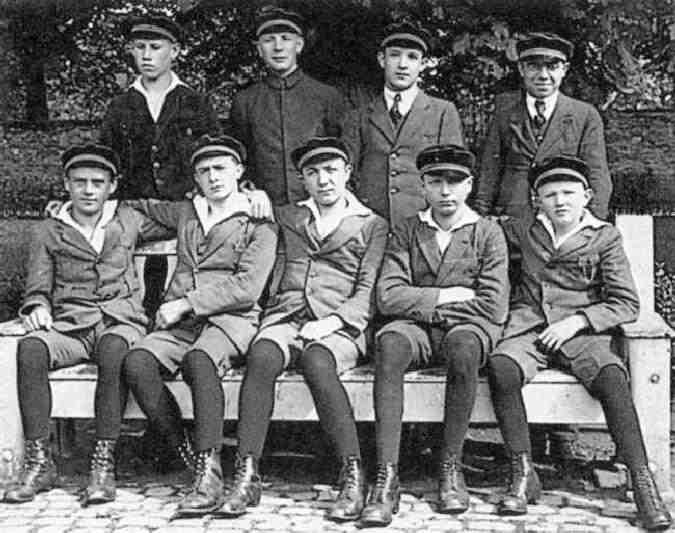
German Schoolwear Garments: Chronological Trends--The 1920s

Figure 1.-- This photograph of a group of mid-level Gymnasium boys was taken
in 1926 during the Weimar Republic period. We don't know the name of the school or the exact location. The boys look almost like they are wearing a school uniform, but in fact their suits are different. It ws common for boys to wear short pants and knee pants. Some what less common here is the uniformity in hosiery which was usually more varied. Often we see German boys during the 1920s wearing a mixture of knee socks and long stockings rather than all long stockings like the boys here. There also tended to be variations in the colors. Click on the image for a fuller discussion.
|
|
We see German boys wearing a wide range of garments in the 1920s. This depended somewhaton age and the type of school. Headwear varied in primary schools. Headwar was more standardized in secondary schools. Many boys wore the military styled school cap in the 1920s. Some primary school boys wore them, but they were most common in secondary schools. Sailor suits continued to be popular schoowear in the 1920s, but not nearly as popular as before World War I (1914-18). We see primary school children dressing more casually, wearing garments like sweaters. Boys attending secondary schools still generlly wore suits, although often not with ties. Boys also continued wearing shortened-length pants. Knee pants transitioned into short pants. Older boys might wear knickers or long pants. Boys wearing knee pants and short pants commonly wore long stockings, although this was somewhat seasonal. This was most common for boys in primary school, but we also see younger teenagers in secondary school wearing long stockings. Black long stockings were prevalebnt in the early 20s, but we begin to see more lighter colors like light brown and grey by the end of the decade. Girls might wear white long stockings.
We see German boys wearing a wide range of garments in the 1920s. This depended somewhaton age and the type of school. Headwear varied in primary schools. Headwar was more standardized in secondary schools. Many boys wore the military styled school cap in the 1920s. Some primary school boys wore them, but they were most common in secondary schools. Sailor suits continued to be popular schoowear in the 1920s, but not nearly as popular as before World War I (1914-18). This was most common for boys in primary school, but we also see younger teenagers in secondary school wearing long stockings. Black long stockings were prevalebnt in the early 20s, but we begin to see more lighter colors like light brown and grey by the end of the decade. Girls might wear white long stockings. We continue to see high-top shoes being commonly worn, but we see more low-cut shoes by the end of the decade. Boys also continued wearing shortened-length pants. Knee pants transitioned into short pants. Older boys might wear knickers or long pants. Boys wearing knee pants and short pants commonly wore long stockings, although this was somewhat seasonal, especially by the end of the decade..
School Level
Clothing was affected by the type of school and level. We see primary school children dressing in quite varied outfits. They might wear suits and other dressy outfits, but they also often wore more casual outfits as well such as sweaters. We see boys at secondary schools dressing more formally. I think this was more the parents or boys choices rather than school dress codes. Boys attending secondary schools still generlly wore suits, although often not with ties. Open Schiller collars were popular in the 1920s. Secondary school attendance was significantly impacted by social class. Most working-class children in the 1920s did not extend their education beyond primary school. This meant that the clothing worn in secondary schools also reflected class and thus family income differences.
HBC-SU

Related Chronolgy Pages in the Boys' Historical Web Site
[Main Chronology Page]
[The 1880s]
[The 1930s]
[The 1940s]
[The 1950s]
[The 1960s]
[The 1970s]
[The 1980s]
Related Style Pages in the Boys' Historical Web Site
[Main school uniform page]
[Main country page]
[Long pants suits]
[Short pants suits]
[Socks]
[Eton suits]
[Jacket and trousers]
[Blazer
[School sandals]
Navigate the Boys' Historical Clothing School Uniform Pages
[Return to the Main German 20th century school garment chronology page]
[Return to the Main German headwear page]
[Return to the Main national school cap page ]
[Australia]
[England]
[France]
[Italy]
[Japan]
[New Zealand]
[Scotland]
[United States]
Navigate the Boys' Historical Clothing Web Page
[Introduction]
[Activities]
[Biographies]
[Chronology]
[Clothing styles]
[Countries]
[Bibliographies]
[Contributions]
[FAQs]
[Glossaries]
[Images]
[Links]
[Registration]
[Tools]
[Boys' Clothing Home]
Created: 7:44 PM 5/13/2007
Last updated: 7:44 PM 5/13/2007




